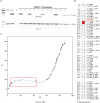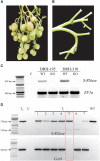Overcoming Self-Incompatibility in Diploid Potato Using CRISPR-Cas9
- PMID: 31001300
- PMCID: PMC6454193
- DOI: 10.3389/fpls.2019.00376
Overcoming Self-Incompatibility in Diploid Potato Using CRISPR-Cas9
Abstract
Potato breeding can be redirected to a diploid inbred/F1 hybrid variety breeding strategy if self-compatibility can be introduced into diploid germplasm. However, the majority of diploid potato clones (Solanum spp.) possess gametophytic self-incompatibility that is primarily controlled by a single multiallelic locus called the S-locus which is composed of tightly linked genes, S-RNase (S-locus RNase) and multiple SLFs (S-locus F-box proteins), which are expressed in the style and pollen, respectively. Using S-RNase genes known to function in the Solanaceae gametophytic SI mechanism, we identified S-RNase alleles with flower-specific expression in two diploid self-incompatible potato lines using genome resequencing data. Consistent with the location of the S-locus in potato, we genetically mapped the S-RNase gene using a segregating population to a region of low recombination within the pericentromere of chromosome 1. To generate self-compatible diploid potato lines, a dual single-guide RNA (sgRNA) strategy was used to target conserved exonic regions of the S-RNase gene and generate targeted knockouts (KOs) using a Clustered Regularly Interspaced Short Palindromic Repeats/CRISPR-associated protein 9 (Cas9) approach. Self-compatibility was achieved in nine S-RNase KO T0 lines which contained bi-allelic and homozygous deletions/insertions in both genotypes, transmitting self compatibility to T1 progeny. This study demonstrates an efficient approach to achieve stable, consistent self-compatibility through S-RNase KO for use in diploid potato breeding approaches.
Keywords: CRISPR-Cas9; S-RNase; diploid potato; gene editing; self-incompatibility.
Figures





Similar articles
-
HT-B and S-RNase CRISPR-Cas9 double knockouts show enhanced self-fertility in diploid Solanum tuberosum.Front Plant Sci. 2023 May 31;14:1151347. doi: 10.3389/fpls.2023.1151347. eCollection 2023. Front Plant Sci. 2023. PMID: 37324668 Free PMC article.
-
Molecular Approaches to Overcome Self-Incompatibility in Diploid Potatoes.Plants (Basel). 2022 May 17;11(10):1328. doi: 10.3390/plants11101328. Plants (Basel). 2022. PMID: 35631752 Free PMC article. Review.
-
CRISPR/Cas9-mediated knockout of PiSSK1 reveals essential role of S-locus F-box protein-containing SCF complexes in recognition of non-self S-RNases during cross-compatible pollination in self-incompatible Petunia inflata.Plant Reprod. 2018 Jun;31(2):129-143. doi: 10.1007/s00497-017-0314-1. Epub 2017 Nov 30. Plant Reprod. 2018. PMID: 29192328
-
Allelic diversity of S-RNase alleles in diploid potato species.Theor Appl Genet. 2016 Oct;129(10):1985-2001. doi: 10.1007/s00122-016-2754-7. Epub 2016 Aug 6. Theor Appl Genet. 2016. PMID: 27497984 Free PMC article.
-
Molecular mechanism of the S-RNase-based gametophytic self-incompatibility in fruit trees of Rosaceae.Breed Sci. 2016 Jan;66(1):116-21. doi: 10.1270/jsbbs.66.116. Epub 2016 Jan 1. Breed Sci. 2016. PMID: 27069396 Free PMC article. Review.
Cited by
-
Genome editing for horticultural crop improvement.Hortic Res. 2019 Oct 8;6:113. doi: 10.1038/s41438-019-0196-5. eCollection 2019. Hortic Res. 2019. PMID: 31645967 Free PMC article. Review.
-
HT-B and S-RNase CRISPR-Cas9 double knockouts show enhanced self-fertility in diploid Solanum tuberosum.Front Plant Sci. 2023 May 31;14:1151347. doi: 10.3389/fpls.2023.1151347. eCollection 2023. Front Plant Sci. 2023. PMID: 37324668 Free PMC article.
-
Jan and mini-Jan, a model system for potato functional genomics.Plant Biotechnol J. 2025 Apr;23(4):1243-1256. doi: 10.1111/pbi.14582. Epub 2025 Jan 23. Plant Biotechnol J. 2025. PMID: 39846980 Free PMC article.
-
Molecular Approaches to Overcome Self-Incompatibility in Diploid Potatoes.Plants (Basel). 2022 May 17;11(10):1328. doi: 10.3390/plants11101328. Plants (Basel). 2022. PMID: 35631752 Free PMC article. Review.
-
Generation of transgene-free PDS mutants in potato by Agrobacterium-mediated transformation.BMC Biotechnol. 2020 May 12;20(1):25. doi: 10.1186/s12896-020-00621-2. BMC Biotechnol. 2020. PMID: 32398038 Free PMC article.
References
LinkOut - more resources
Full Text Sources
Other Literature Sources
Research Materials
Miscellaneous

